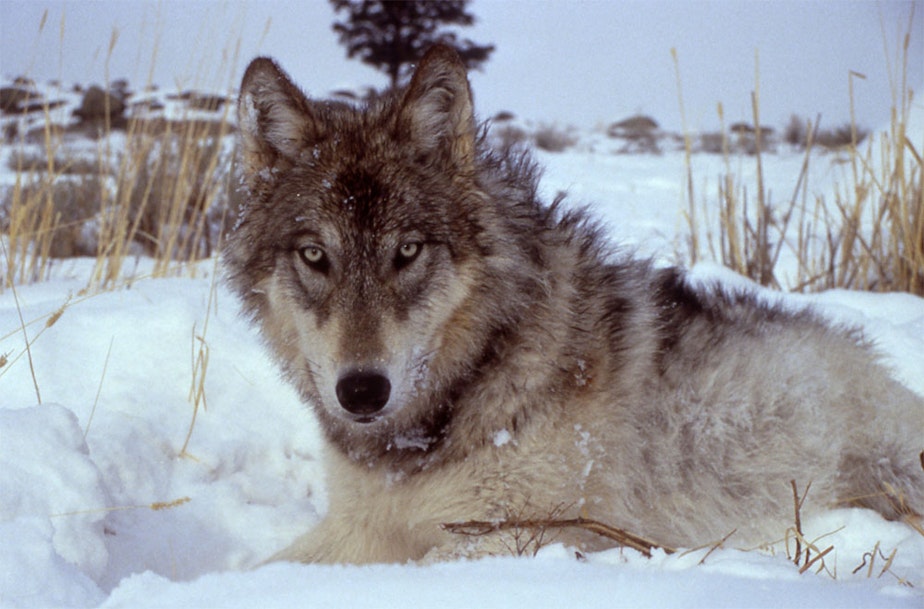Study: people mean different things when they talk about managing wolves through fear

As in many arguments, opposing sides don’t always speak the same language. Such is the controversy of wolf management in the West, which is why new research found it’s important to clarify what people mean when they talk about managing the predators.
Wolves need to fear people so that they can coexist with people and livestock. However, wildlife managers and livestock producers often misunderstand each other when they talk about wolf management and fear, according to the paper, published in The Canadian Geographer.
Increasingly, politics and people influence wolf behavior, lead author Rob Anderson argued in the paper.
That’s why, as a part of his doctorate in geography from the University of Washington, Anderson conducted an ethnographic study of wolf management in the state, taking a close look at how fear plays a role for wildlife biologists and livestock producers as they interact with wolves.
In his research, Anderson found biologists, livestock producers, and rural residents think about fear differently with regard to wolves, which he said can create misunderstandings.
For example, when talking about lethal removal, some livestock managers want retribution for livestock killed by wolves; others told Anderson they believe managers should only use lethal removal when they can’t rehabituate a wolf through non-lethal methods, like loud noises and flashing lights. Other people said they hoped wolves could assess risks and pass along fear of some risks to the next generation.
“The failure to distinguish between these different meanings of the concept of ‘changing wolf behavior’ makes it difficult for anyone to clearly articulate precisely what conflict reduction efforts are intended to accomplish,” Anderson wrote in the paper.
That can lead to misunderstandings in policy meetings, he wrote.
“One of our goals with our research was to be precise about the possible meanings of ‘changing wolf behavior’ so that people who are trying to manage wolves can better understand each other,” Anderson said.
In wildlife ecology, he said, people often assume it’s natural that wolves fear people, an ecological term called innate fear.
However, wolves’ fear of people isn’t innate, he said. That fear is born from a history of persecution, Anderson said.
“What probably happened is the wolves that were the least afraid, the most bold or fearless wolves, were the ones that were most likely to be killed off. The wolves that survived for the last couple of centuries in North America are more likely to be fearful,” he said.
Now, the coexistence between people and wolves is predicated on wolves fearing people, Anderson said.
That’s not a bad thing, he said.
“It’s important to recognize that wolf fear is actually the goal, not a natural state or the way things are supposed to be,” Anderson said. “It’s actually a management goal.”
The state kills wolves or wolf packs with documented four or more depredations over a year or six or more depredations over two years, unless there are extraordinary circumstances. At least one depredations must have killed livestock and producers must have previously used non-lethal deterrent measures. Anderson said Washington most often focuses on non-lethal management tools that instill fear in wolves.
“I think part of the challenge and the degree of misunderstanding is around what it means to ‘send a message to the wolves’ or to get wolves to change their behavior,” Anderson said. “I hope the range of possible meanings in some of that language will help clarify the conversation.”
Next, Anderson said, more study needs to be done to better understand how wolves respond to fear on an individual level, in packs, and on an evolutionary level.
Wildlife officials documented the first breeding pair in Washington in 2008. Since then, the state’s wolf population has increased by an average of 25% each year, according to the Department of Fish and Wildlife.
The most recent wolf counts in Washington found at least 206 known wolves and 33 known wolf packs, including at least 19 breeding pairs. Most of the known wolf packs are concentrated in northeastern Washington.
Wolves are listed on the state’s endangered species list. After a reversal of the Trump administration’s decision to delist gray wolves, wolves also are included on the federal endangered species list in the western two-thirds of Washington.
Several scenarios would allow wolves to be delisted in the state. The first scenario would require 15 successful breeding pairs across three regions for three consecutive years. Another scenario would require 18 successful breeding pairs, with four successful breeding pairs in each region and six additional breeding pairs anywhere in the state.
This past year, police with the Department of Fish and Wildlife have investigated six wolf poisoning deaths in Stevens County. Wildlife advocacy groups have offered $53,900 for information that leads to a conviction in the wolf killings. [Copyright 2022 Northwest News Network]
